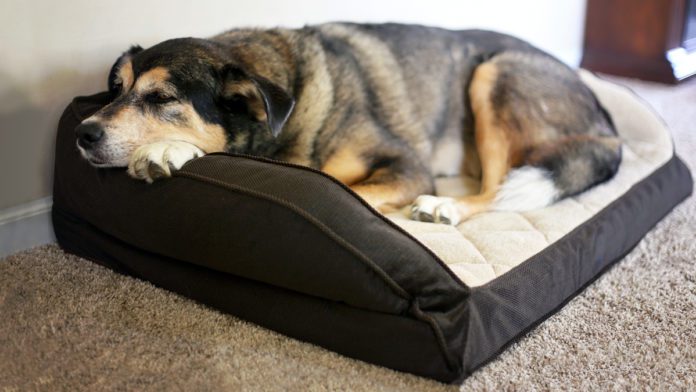
Osteoarthritis (OA) is a prevalent disease affecting various dog species. In fact, research reveals that osteoarthritis affects up to a quarter of the population. OA is a progressive medical condition, and its diagnosis can be overwhelming.
Since up to 20% of all dogs are affected by osteoarthritis, it is the most common chronic disease they face. Successfully managing your dog’s osteoarthritis means boosting its comfort levels and minimizing pain levels. Here, we discuss osteoarthritis in dogs is, its signs and symptoms, and how you can manage it:
What is Osteoarthritis?
Osteoarthritis is a progressive disorder that causes deterioration of joints and cartilage. Also known as degenerative joint disease, your furry friend’s cartilage stops functioning properly in this condition.
In healthy dogs, cartilage acts as a cushion, allowing your dog’s joints to move smoothly. However, in osteoarthritis, the cartilage cushion suffers from damage and starts breaking due to injury, excessive stress, disease, or aging.
As a result, your dog may experience pain, decreased range of motion, inflammation, and bone spurs.
Causes of Osteoarthritis in Dogs
Although the scientific cause of osteoarthritis is yet to be proven, multiple scientists believe that developmental orthopedic diseases lead to this condition.
Orthopedic diseases, including hip and elbow dysplasia, are influenced by various environmental, genetic, and polygenic factors. According to Orthopedic Foundation for Animals, at least 21% of the 50 most-affected breeds suffer from hip dysplasia.
On the other hand, up to 16% of dogs suffer from elbow dysplasia. Osteoarthritis in dogs is also prevalent in shoulder joints, but veterinary experts have yet to learn about its development and risk factors. Another study reveals that shoulder joint pain is dominant in about 57% of eight-year-old dogs. Moreover, up to 86% of overweight dogs suffer from shoulder joints.
Natural gaining and joint wear may also cause arthritis. Various other risk factors contribute to the development of osteoarthritis in dogs.
The Stages of Osteoarthritis
Understanding the functional impact of osteoarthritis in dogs makes it easy for pet parents to know which signs and symptoms to look out for.
Often, in the first two stages, osteoarthritis is difficult to notice. It is because signs and symptoms are mild in the first two stages. In most cases, osteoarthritis signs include minor loss of strength, acute joint pain, and low fitness.
In most cases, veterinarians diagnose osteoarthritis in its 3rd stage when your dog starts experiencing chronic pain. Your vet may also diagnose it from a significant loss of strength.
In the last and final stage, your dog may start losing its ability to walk. It is typically because of chronic pain, a decline in fitness and strength, and loss of joint motion. Multiple doctors believe that the clinical sign is because of a loss of motivation.
Signs and Symptoms of Osteoarthritis
Osteoarthritis is comparatively difficult to detect in its early stages. Monitor your dog closely and lookout for the following signs and symptoms:
- Behavioral changes
- Difficulty posturing when urinating or defecating
- Irritability or changes in behavior
- Increase in accidents in the house
- Issues when trying to get up
- Lethargy
- Limping
- Loss of muscle mass on the spine and over the limbs
- Pain upon being touched and petted
- Reluctant to run, play, and jump
- Stiffness and lameness
- Swollen joints
- Weight gain
If you observe any of these, you should consult an experienced vet for a complete physical examination. Your vet may also assess your furry friend’s range of motion and palpate its joints.
Pain and Osteoarthritis

Osteoarthritis refers to a progressive degenerative condition that affects your dog’s articular cartilage. The disease then spreads throughout your dog’s joints and structures.
The decline in cartilage is progressive, and over time, your dogs’ joints may stop functioning due to articular damage and cartilage destruction. Clinical problems that occur during the four stages of osteoarthritis may cause chronic pain.
At this point, pet parents must attempt to control and managing this progressive disease to lower pain levels. With the help of various treatment plans, you can successfully reduce your dog’s pain and help it become healthier.
Risk Factors of Osteoarthritis in Dogs
Although any dog can indeed develop osteoarthritis, certain factors put them at risk. These are as follows:
- Age, primarily middle-aged and senior dogs
- Genetics
- Improper nutrition
- Infections that affect its joints
- Injuries from ligament tears and fractures
- Large or giant breeds
- Obesity
- Poor conformation
- Prior diagnosis of the elbow or hip dysplasia
- Repetitive stress from athletic activities like diving, agility, flyball
Which Breeds are at Risk of Osteoarthritis?
While most people believe that arthritis only occurs in senior dogs, the fact remains that it can happen to dogs of any age. In fact, insightful research reveals that 80% of dogs develop osteoarthritis by age 8. Plus, 20% of dogs show signs of osteoarthritis by the age of 1.
Let’s discuss which breeds are at risk of developing osteoarthritis:
High Risk
Following breeds of dogs have a higher risk of arthritis:
- Beagles
- Bulldogs
- Cocker Spaniels
- German Shepherds
- Golden Retrievers
- Labrador
- Mixed Breeds
- Pit Bull
Medium Risk
Here we’ve listed dog breeds that have a medium risk of developing osteoarthritis:
- Airedale Terrier
- Basset Hound
- Beagle
- Boxer
- Poodle
- Siberian Husky
- Shih Tzu
- Standard Schnauzer
- Terrier
Low Risk
Let’s discuss dog breeds that have a low risk of developing osteoarthritis:
- Australian Kelpie
- Fox Terrier
- French Bulldog
- German Pointer
- Jack Russell Terrier
- Miniature Schnauzer
- Pug
- Saluki
- Silky Terrier
- Tenterfield Terrier
Diagnosis for Osteoarthritis

Vets diagnose osteoarthritis via a physical exam, several imaging modalities, and the patient’s medical history. These are as follows:
- In the first step, your vet will take a physical exam of your dogs’ affected joints and then assess their limbs’ response to pain. They will also look for joint fluid, thickening of any joint capsule, and muscle atrophy.
- In the next step, vets may use X-rays to get further information on your dog’s bone structural changes. Plus, this innovative tech can provide imaging of its soft tissue changes.
- Lastly, they may use diagnostic tools like magnetic resonance imaging (MRI) that offer insightful information about computed tomography and soft tissue structures. With this revolutionary technology, your veterinarian can assess your dogs’ elbows, tarsi, and wrists.
How to Make your Dog Feel More Comfortable?
Combine your dog’s arthritis treatment plan with various environmental and routine changes to minimize pain. Here are a couple of changes you should make in your dog’s life to make it feel comfy:
- Consider purchasing an orthopedic foam dog bed or providing it soft bedding
- Keep your dog’s coat healthy and groom with the help of regular brushing sessions to compensate for decreased flexibility
- Switch to gentle play sessions and leashed walks
- Raise water bowls off the ground to avoid straining your dogs’ neck
- Use a portable ramp to access the sofa or car
By diagnosing arthritis at an early age, you can ensure your dog is healthy and happy.
Treatment Plans of Osteoarthritis in Dogs
Osteoarthritis isan incurable, degenerative disease. However, you can prevent its onset with the help of a proper treatment plan, diet, and exercise.
When osteoarthritis starts spreading throughout your dogs’ body, your vet may curate treatment plans that help control pain, enhance the quality of life, decrease inflammation, and slow down its development. Your vet may recommend the following treatment plans:
Gabapentin
Gabapentin resembles the structure GABA but has zero effect on GABA degradation and uptake. Instead, it increases and flow of calcium and puts a brake on the release of excitatory neurotransmitters.
Although this medication was designed as an anti-seizure, it is popularly used for pain management and neurologic. There may be specific side effects such as GI upset, sedation, and ataxia.
Your vet may recommend an initial dose of 10mg/kg and after 8 hours to ensure efficiency. The dose may be increased over time.
Joint Supplements
Vets may prescribe to help reduce inflammation, enhance function, and slow down joint and muscle damage progression.
Chondroitin and Glucosamine are the most common joint supplement ingredients for dogs, as well as humans. These supplements focus on reducing inflammation, increasing water retention in its cartilage to improve cushioning and promote healing.
Another fantastic joint supplement for dogs is green-lipped mussels, which contain nutrients like antioxidants and omega-3 fatty acids. GLM is an anti-inflammatory and powerful supplement that enhances joint function and reduces pain.
Lastly, joint supplements like GMC are used during the early stages of osteoarthritis because they don’t pose any side effects for your dog.
NSAID’s
To help manage your furry friends’ pain, your vet may recommend NSAIDs. Non-Steroidal Anti-Inflammatory Drugs are an effective way of reducing pain and inflammation in their joints.
However, keep in mind that NSAIDs’ can have side effects and affect your dog’s liver or kidney. Make sure you discuss benefits, side effects, and risks with your veterinarian before giving them to your dog.
Your vet may even request you to do regular blood work to monitor your dog’s health.
Rehabilitation
Animal rehabilitation includes several exercises that help enhance joint mobility and boost exercise endurance. These are as follows:
- Aqua therapy is like an underwater treadmill
- Joint mobility
- Increase muscle mass
- Motion exercises
- Swimming
- Therapeutic exercises
Your vet may also recommend acupuncture and LASER therapy to improve your pet’s health and exercise endurance.
Stem Cell Therapy
A stem cell refers to a blank cell that can be transformed into your desired type of cell. These cells can regenerate in a specific part of their body.
The vet extracts a stem cell from your pet’s umbilical cord blood, bone marrow, or fat in pet stem cell therapy. According to research, up to 78% of dogs showed improvements after a single month of stem cell therapy and 88% after six months.
Surgical Management
The vet may recommend surgical management if the condition is severe. The surgery may be one of the following:
- Treatment of the Primary Cause- These includes suture-based and osteotomy-based techniques for knee cranial cruciate ligament rupture
- Salvage Procedures- These helps remove painful joint components like FHNE
- Total Joint Replacement Surgery- This typically occurs in stifles, hips, and elbows
Additional Treatments
Your vet may recommend other treatments like cold laser, acupuncture, physiotherapy, and changes in diet.
Multimodal Management
Pet parents should follow a practical and multimodal management plan to achieve proper pain control and maintain it in osteoarthritic dogs. This holistic approach to pain management is more beneficial than an analgesic or anti-inflammatory medical agent.
Multimodal approaches involve therapeutic options instead of just surgical and non-surgical processes.
Nutrition for Osteoarthritic Dogs
Your dog’s nutrition and joint health can have a significant impact on your osteoarthritis. Let’s discuss how food and weight management prevent its development:
Nutrition and Weight Management to Prevent Osteoarthritis
Regardless of what your dog’s joint health looks like, you must help it exercise and stay active. Here’s how weight management and supplements can help your furry friend:
Weight Management
Ensure your adorable pet gets regular exercise by taking it out on walks and focusing on physical therapy. In addition, make sure your dog follows a healthy diet. This way, you can postpone your dog’s onset of osteoarthritis.
Since obesity is a risk factor, excess weight can speed up the development of osteoarthritis. For this reason, your dog must maintain a healthy weight.
Joint Supplements
Nutritional supplements are a popular and effective way of ensuring joint health and can help boost your pet’s critical joint-protecting cartilage.
With the help of joint supplements like Glyco-Flex and Dasquin, you can help reduce risks and the onset of osteoarthritis.
Nutrition and Weight Management to Manage Osteoarthritis
Here’s how nutrition and weight management can help manage osteoarthritis:
Weight Management
Keeping trim and a healthy figure is necessary for managing and controlling osteoarthritis. Extra weight on its spine and neck can further burden your pet’s muscles and joints, especially when your furry friend is already suffering from painful symptoms.
In case your dog has excess weight, discuss with your vet and curate a weight-loss plan. Try to keep treats at a minimum and, if possible, entirely cut them off.
Supplements
Nutritional supplements like omega-3 fatty acids in fish oil and the EPA can aid cartilage production and ease inflammation.
Chondroitin and Glucosamine are two incredible supplements that can boost your furry friend’s joint health. Glucosamine refers to a nutrient present in your pet’s body and is a building block for chondroitin. It helps in preventing damage, pain, and friction between your pet’s bones.
Can Your Dog’s Weight Make a Difference?
Yes. If your dog carries additional weight, you should consider discussing it with your vet.
Plan an effective weight loss diet to help get your dog at a healthy weight. Your veterinarian may even provide joint support.
Make sure you question your doctor about specific portions, curate a day-to-day schedule, and monitor your dog’s weight.
How Long Can my Dog Live with Osteoarthritis?
Fortunately, dogs with osteoarthritis can have a standard lifespan given that they aren’t suffering from other underlying conditions and symptoms are under control.
Just like in humans, older dogs are more susceptible to health complications and medical conditions. Your dog’s arthritis may develop with time; however, with the proper regime and a holistic treatment plan, you can help them stay healthy for longer.
The Bottom Line
According to research, managing pain via pain medications is often the first step towards recovery and managing osteoarthritis. Further investigation reveals that physical rehabilitation, including swimming, is an excellent way to keep your dog fit, healthy, and happy.
You can do various things to make your dog’s life comfier and less painful. For instance, raising your dog’s water dishes and providing a soft bed can alleviate lower-back and neck pain.
Although osteoarthritis is a painful condition, you can manage and control it. Maintain your dog’s health and physical activity and monitor your dog’s behavior and health to spot signs of OA in its early stages.
Sources
https://go.parnell.com/en-us/arthritis-in-dogs
https://www.acvs.org/small-animal/osteoarthritis-in-dogs
https://www.veterinarypracticenews.com/osteoarthritis-june-2020/
https://www.pagepress.org/journals/index.php/vsd/article/view/5931/6327
https://www.petcarerx.com/article/the-complete-guide-to-dog-arthritis/1391
https://www.petcarerx.com/article/nutrition-for-arthritic-dogs-and-cats/766
https://vcahospitals.com/know-your-pet/helping-your-dog-with-osteoarthritis
https://veterinary-practice.com/article/managing-chronic-osteoarthritis-its-as-easy-as-a-b-c
https://pets.webmd.com/news/20180802/can-arthritic-dogs-benefit-from-stem-cell-therapy


